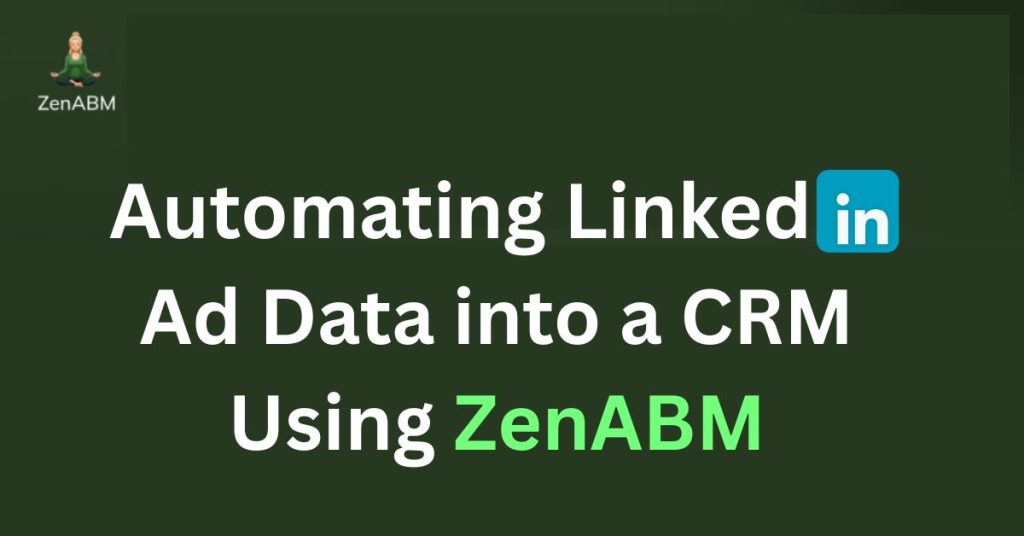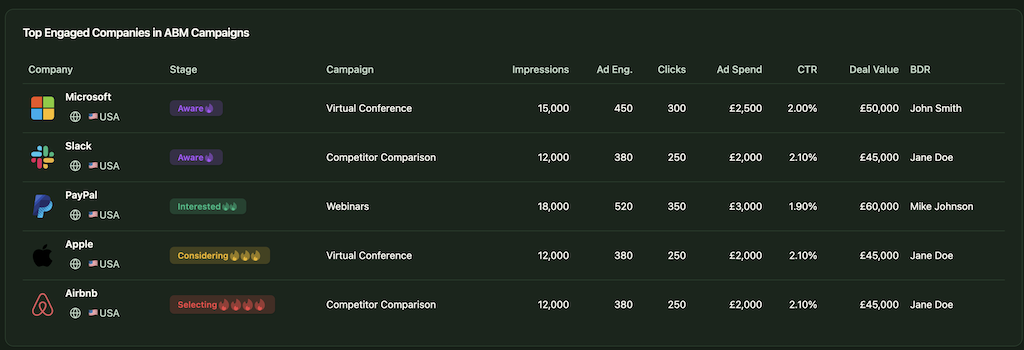Getting LinkedIn ad data to flow into a CRM without manual work is harder than it looks, especially in B2B, where buying journeys span weeks and involve many stakeholders.
Clicks are scarce. Native reports and most CRMs lean on click-through logs and spreadsheet exports. That approach ignores the view-through story almost completely.
In this article, I will explain why click-first reports undercount LinkedIn and then show a practical way to automate the full stream of LinkedIn ad data into a CRM, from impression to revenue, using ZenABM.

Automating LinkedIn Ad Data into a CRM: Quick Summary
- Manual reporting fails because buyers rarely click, and most stacks only store clicks. Any automation must record view-through activity at the account level.
- Why pipelines break today:
- Campaign Manager overview: Provides company-level counts but only as an ad account rollup. You cannot see which company interacted with which specific ad or campaign, so schedules and dashboards stay coarse.
- Website deanonymization: Works only after a click, averages near forty percent accuracy, and struggles with VPNs or shared IPs. Poor input for automation.
- Display networks: Depend on cookies and ageing behavioral graphs. Bot traffic is common. Not a durable source for automated data flows.
- CRMs such as HubSpot: Capture after a form submit. They miss view-through engagement and multi-user influence at the account level, so automated reports undervalue LinkedIn.
- What you really need:
- Campaign-level and company-level engagement that logs impressions even when there is no click.
- Multi-touch attribution across campaigns rather than crediting the last interaction.
- Direct CRM sync so fresh company engagement fields are available for reports, scoring, and workflows.
- How ZenABM solves it:
- Records every company that viewed or interacted with each LinkedIn ad. A click is not required.
- Shows engagement by campaign and by company, so automation can be precise.
- Pushes these metrics to CRMs like HubSpot as company properties you can filter, score, and route on.
- Calculates real-time engagement scores to prioritize accounts.
- Tags campaigns with buyer intent themes and exposes those signals for BDRs.
- Connects ad touches to opportunities and revenue so automated dashboards show true ROI.
- Uses approved, first-party LinkedIn API data. Fully compliant.
- Takeaway: Click-only tools miss most of LinkedIn’s influence. An automated, account-centric pipeline reveals impact across the whole journey.
- Start with ZenABM to automate LinkedIn ad data into a CRM with company-level accuracy.
Why Automation for LinkedIn Ad Data Often Breaks
What makes automated LinkedIn pipelines unreliable?
LinkedIn drives awareness and consideration.
Clicks are uncommon.
The CTR is hardly 0.4 to 0.5%:
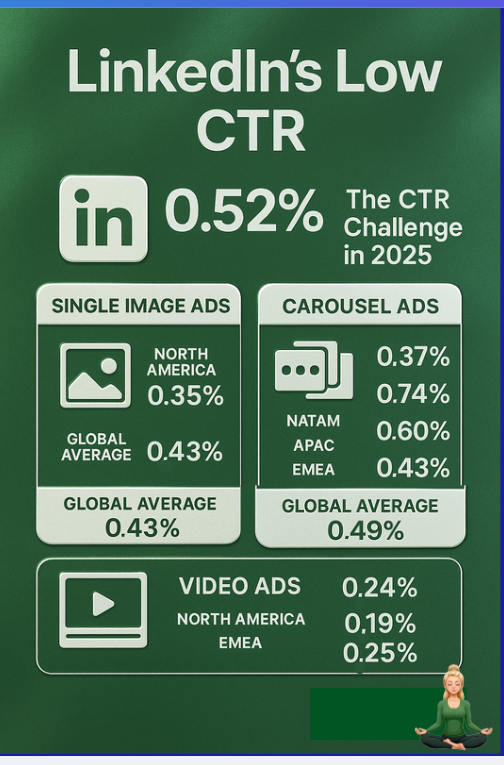
Unlike Google Search, where intent is explicit and a click is likely, LinkedIn users scroll, notice, and act later.
A prospect can view your ad, then search your brand or type your URL directly. Analytics give credit to SEO or direct, and your automated reports miss LinkedIn’s contribution.
The remedy:
Do not rely on clicks alone. To automate correctly, capture view-through activity and store impressions and engagement at the account level, not only clicks.
Teams agree with this idea. The execution is where typical tools fall short:
LinkedIn Campaign Manager
Campaign Manager offered limited account insight for years. In 2020, LinkedIn added the Company Engagement Report. In late 202,4 it became the Companies tab:
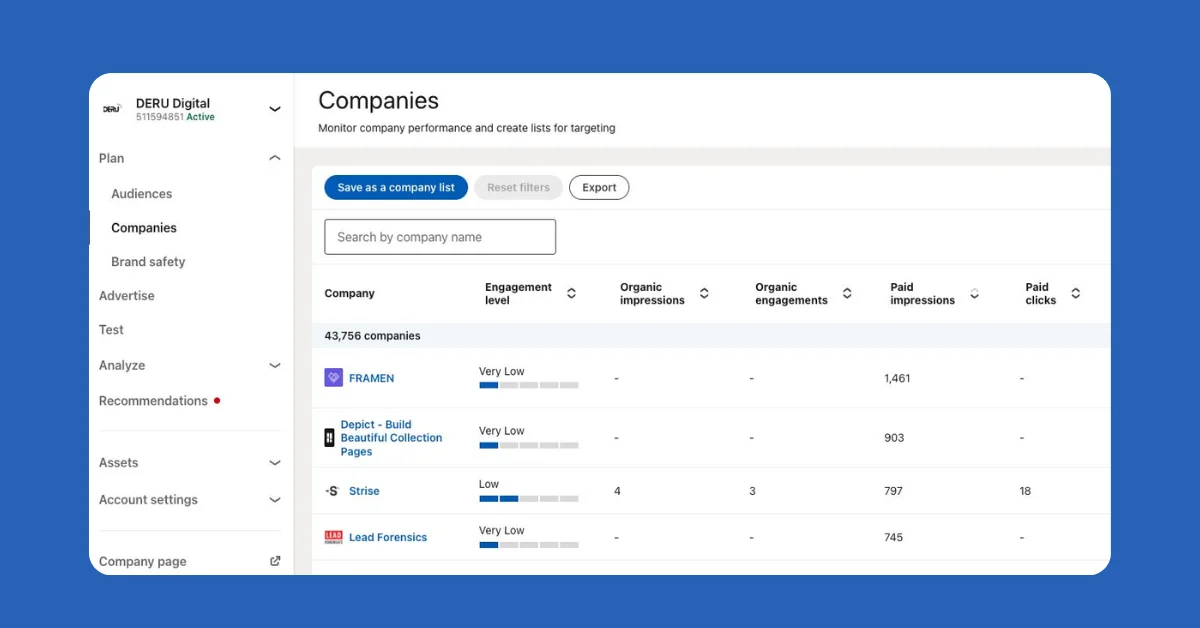
You can view company totals for paid clicks and paid impressions. That is a step beyond clicks.
The limitation is binding. Engagement is not tied to a specific campaign or creative. All company activity rolls up at the ad account level.
So you see that the company is engaged. You do not see which ads were involved.
Most marketers run several ABM programs at once with groups and multiple campaigns beneath each group.
Campaigns differ by:
- Creative and format
- Budget, timing, owner, and frequency
- An intent theme, such as a feature or benefit
Without company data at the campaign layer, you cannot map intent or automate reports with precision.
Here is a layered structure from a real program:
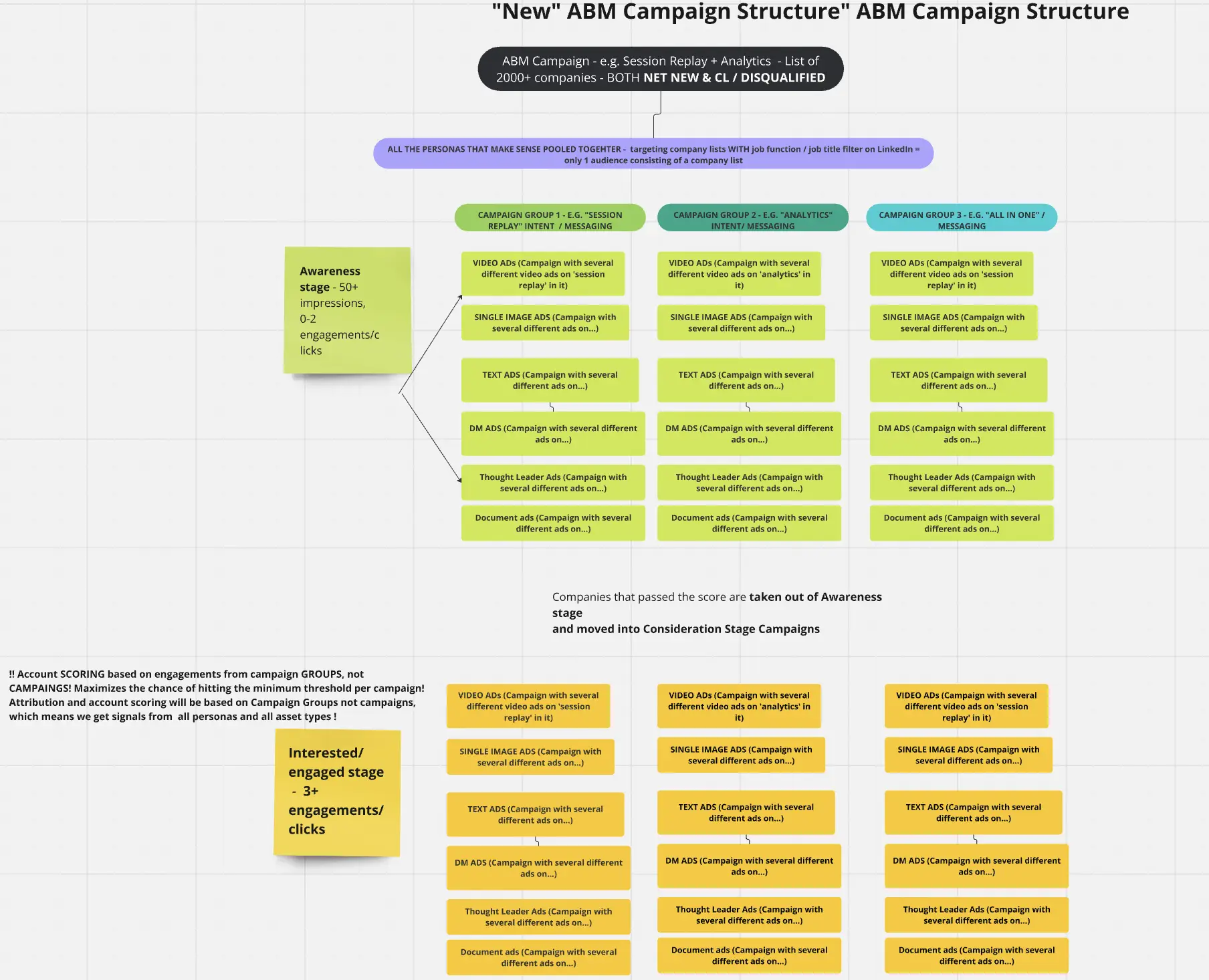
Account rollups are blunt. You need impressions, clicks, and interactions per company for each campaign, group, and ABM motion.
Without that, you cannot automate per campaign reporting or run clean A/B tests. Winners and underperformers stay hidden.
Website Deanonymization
What about tools that say they reveal visiting companies?
Reverse IP can infer a company from an address.
It only triggers after a click and a page view. View-through remains invisible, which is a fatal gap for LinkedIn automation.
Even for click traffic, accuracy is modest, often near forty percent per a Syft research:
Why the gap?
IP mapping breaks with VPNs and shared networks.
Many firms do not register IP blocks, so there is nothing to match:

A practical example. A B2B team tried Clearbit to identify traffic from LinkedIn ads.
Outcome:
Only one company appeared, their own:
If your goal is automated account-level LinkedIn reporting, traditional deanonymization adds little.
Display Networks and Behavioral Matching
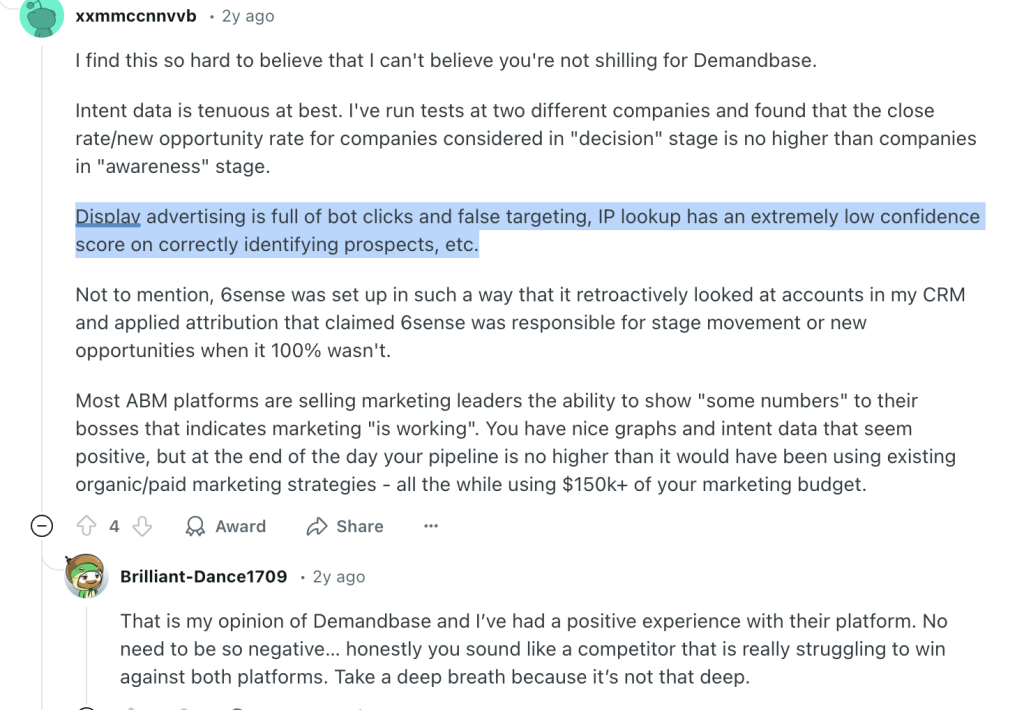
Teams sometimes use AdRoll or Criteo for targeting and enrichment. These rely on third-party cookies and device graphs to guess company or role. That does not fix automated LinkedIn reporting:
- Chrome is removing third-party cookies. Any pipeline that needs them will degrade.
- Profiles go stale when people change roles or employers.
- Bot traffic distorts impressions and clicks, so automated dashboards ingest bad signals.
LinkedIn Ads CRM Connectors
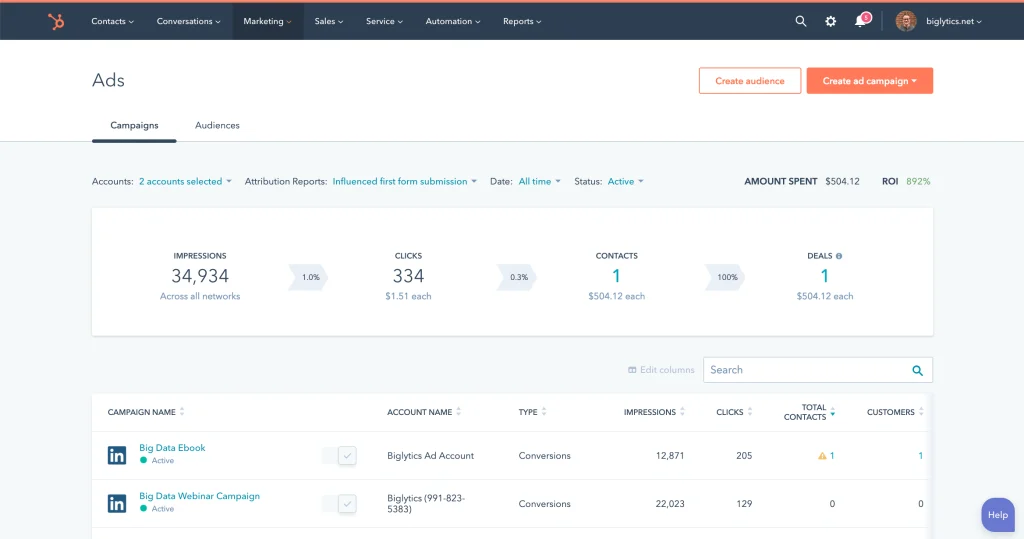
Another option is marketing automation or CRM syncs, such as click to CRM flows or HubSpot’s LinkedIn connector.
HubSpot can connect LinkedIn, sync lead forms, and manage campaigns. For automated reporting, it still will not tell you:
- Which companies viewed specific LinkedIn ads? You only see people who convert.
- Which companies clicked yet never filled a form or converted by another route later?
- Which key accounts keep engaging over time, and what is the pattern you need for routing and alerts?
- How campaigns influence opportunities and deals across the CRM.
You might wonder if HubSpot conversion tracking or the Insight Tag fills the gap. Limits remain:
- If a conversion lacks a company field, you cannot attach it to an account.
- If a person clicks and then submits a form later or from another device, cookie-based logic may not link the moments.
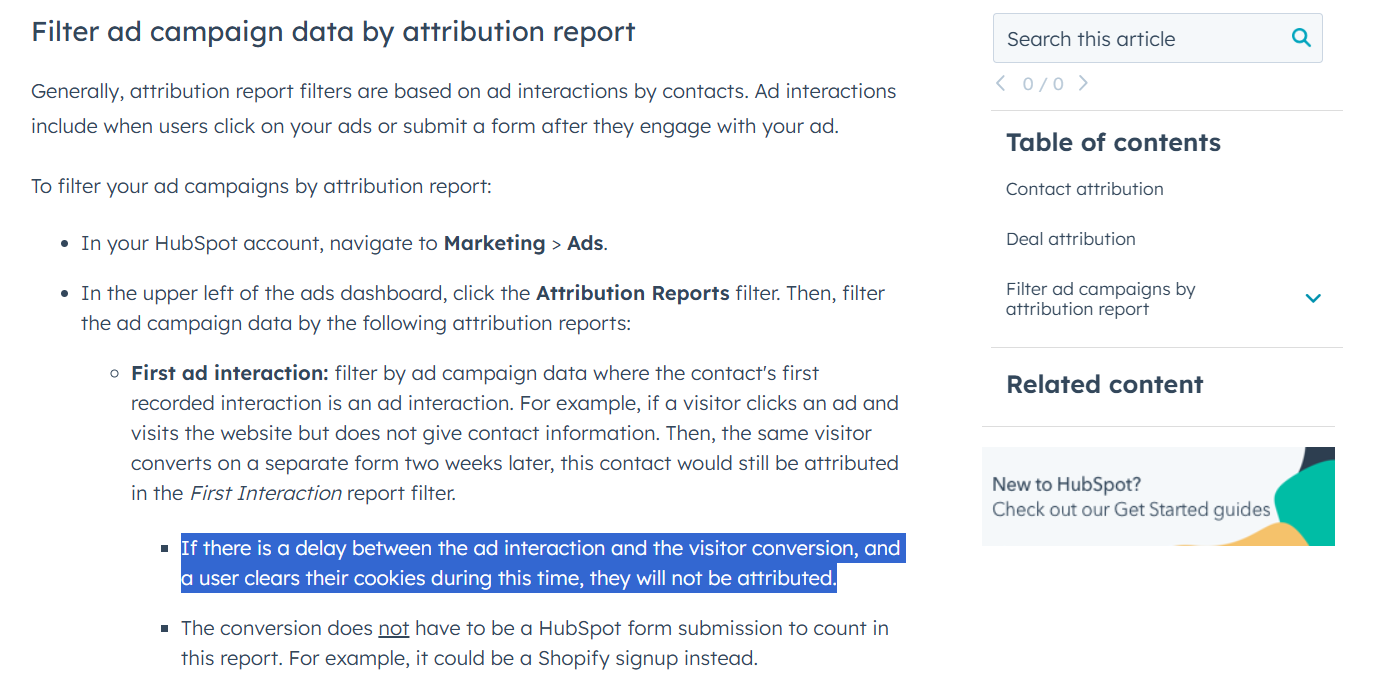
Source: HubSpot Knowledge Base - Influence on non-click viewers is lost. In B2B, one stakeholder sees the ad, another clicks, and a third submits the form. Automated reports must reflect the account, not only the last action.
Bottom lines
- CRMs such as HubSpot focus on click tracking and near-term forms. The same holds for LinkedIn CAPI and the Insight Tag.
- IP matching sounds like a form-free shortcut, yet accuracy is weak, and the click bias remains.
- Campaign Manager’s Companies tab offers view-through at the company level, yet only as an account rollup. You still cannot connect a company to a specific ad or campaign, which keeps automation blunt.
For reliable automation, you need a system that logs company-level ad engagement for every campaign and campaign group, impressions included, and then syncs that data into your CRM on a schedule.
How ZenABM Automates LinkedIn Ad Data into a CRM
ZenABM uses LinkedIn’s official APIs to pull rich company-level engagement for your campaigns. No cookies. No scraping. No guessing.
Here is how ZenABM turns LinkedIn activity into automated CRM ready reporting and ROI:
Captures Every Company That Sees or Interacts
ZenABM lists top engaged companies by campaign with impressions, CTR, engagements, ad spend, CRM deal value, and assigned BDR.
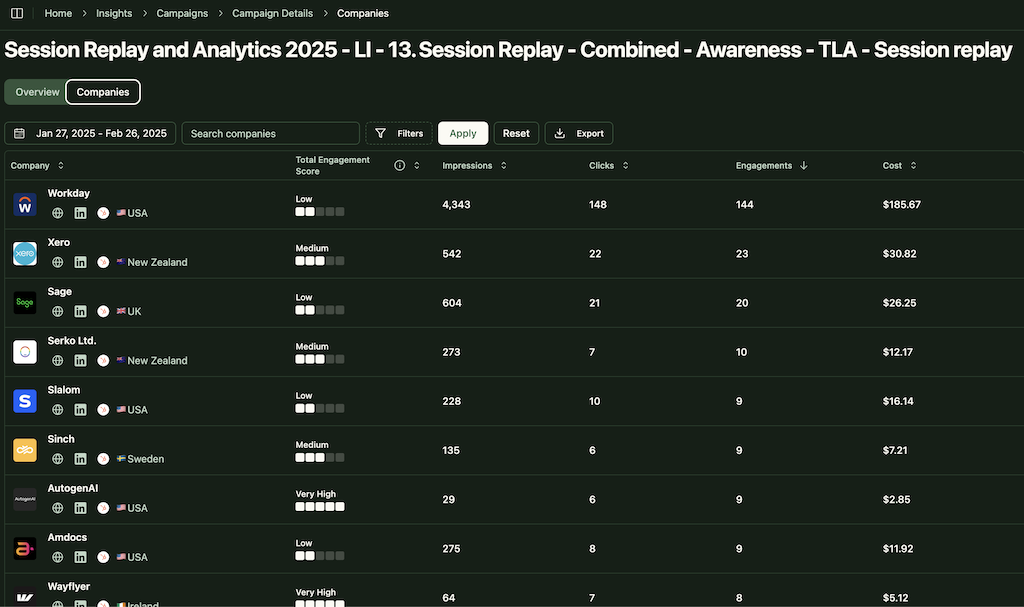
Whether a target account clicks or not, ZenABM records it. The system logs when a company:
- Receives an impression
- Likes, comments, or shares
- Clicks an ad
- Views without visiting your site
You can credit influence even without a form. If Company X sees your ads repeatedly and later books a demo from search or direct, ZenABM still assigns the assist. When several ads run over time, ZenABM shows each touch for true view-through attribution in an automated flow.
Applies Fair Multi-Touch Attribution
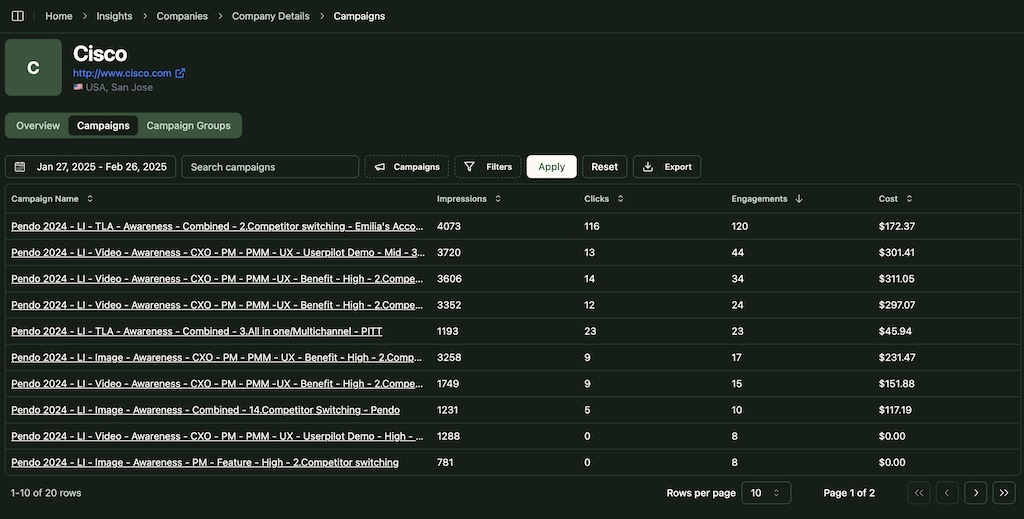
Last click over credits the final touch. Click counts bias toward lower funnel ads.
ZenABM displays the full campaign path at the account level. Early thought leadership gets its share. Mid funnel education gets its share. Your automated dashboards reflect the entire sequence.
Writes Engagement to HubSpot Automatically
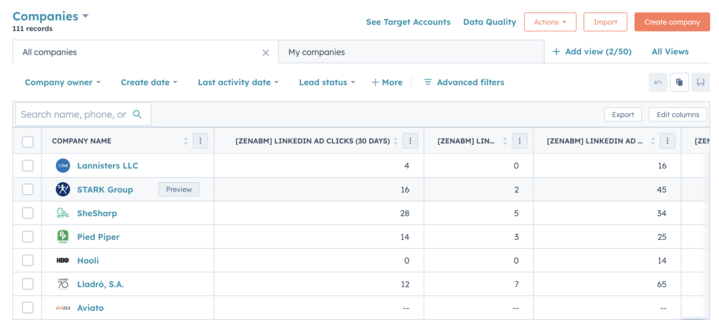
No more CSV juggling.
ZenABM syncs LinkedIn engagement into CRM company properties such as “LinkedIn Ad Impressions last 7 days” or “LinkedIn Ad Clicks last 7 days.” Those values stay fresh. You can report, score, and trigger sequences from live ad data.
Automates Scoring, Routing, and Intent
ZenABM computes a real-time engagement score that weights recency, frequency, and interaction type. Treat it like intent. When a score spikes, the platform can alert sales and route the account in your CRM.
When thresholds are reached, assignment can fire automatically:

Tracks Buyer Intent and Syncs It
Every campaign or group can be tagged with an intent theme such as feature, use case, or pain.
ZenABM clusters companies by these themes so reps know what to lead with.
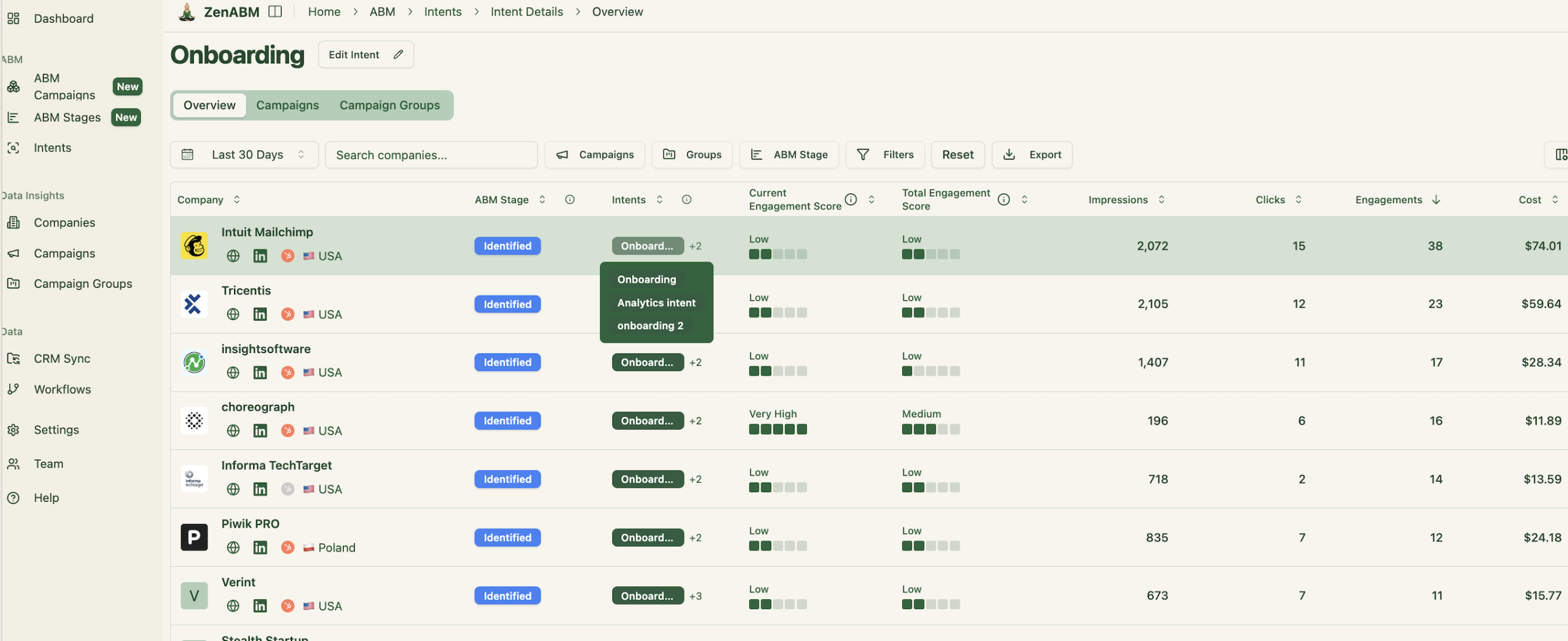
Connects Ads to Pipeline and Revenue

Reliable ROI requires a line from spend to revenue.
ZenABM links company engagement to opportunities and closed deals in your CRM. It matches engaged accounts to pipeline and wins, so your automated revenue reports show contribution rather than just clicks.
Ships With ABM Dashboards

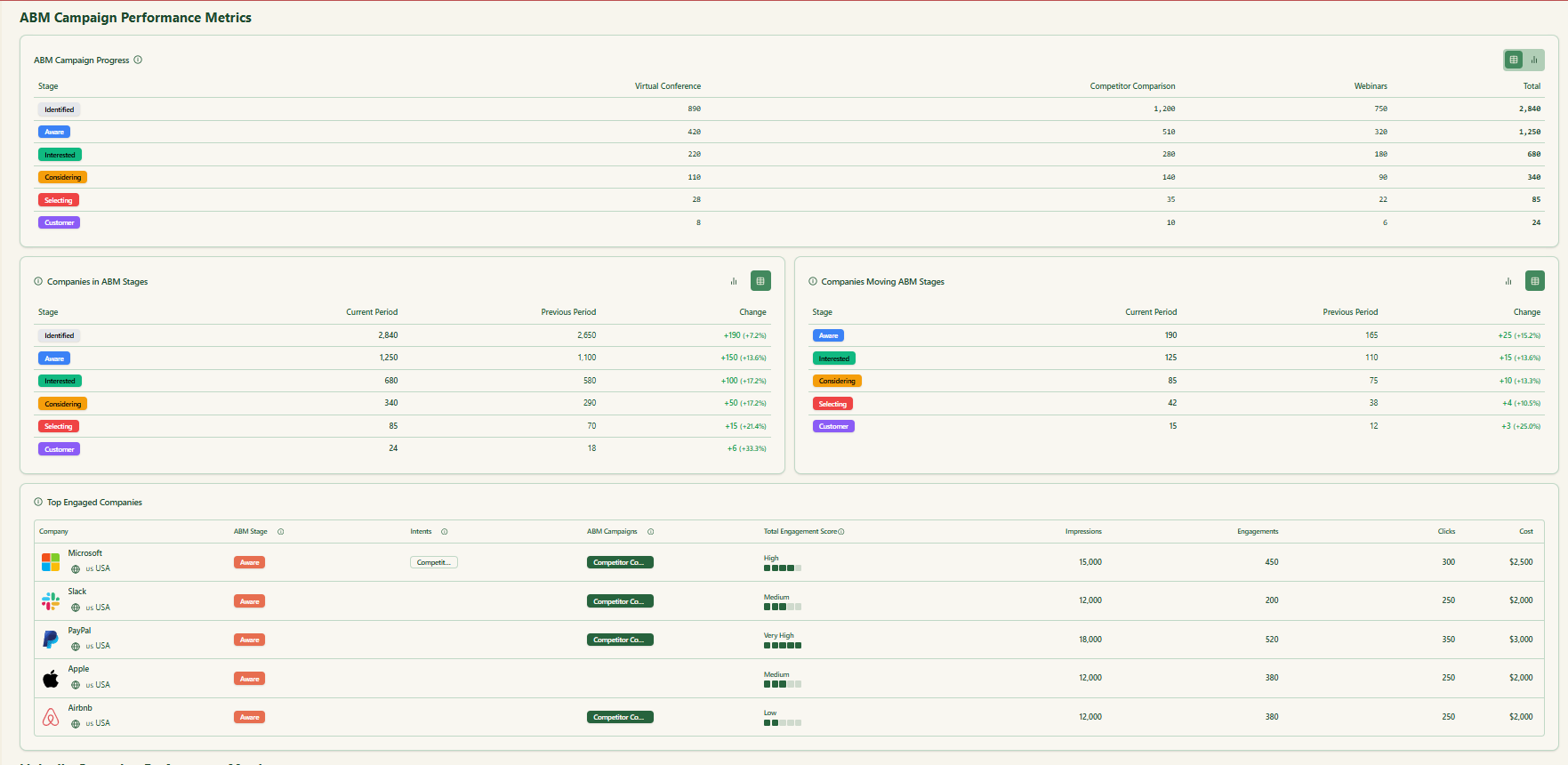

Because ZenABM is designed for ABM, the product includes dashboards that highlight the essentials. You get impressions vs engagement, influenced pipeline, ROI or ROAS, and top accounts without custom SQL. Data refreshes on schedule.
Uses First Party Data and Stays Compliant
LinkedIn is actively enforcing policies against scraping:
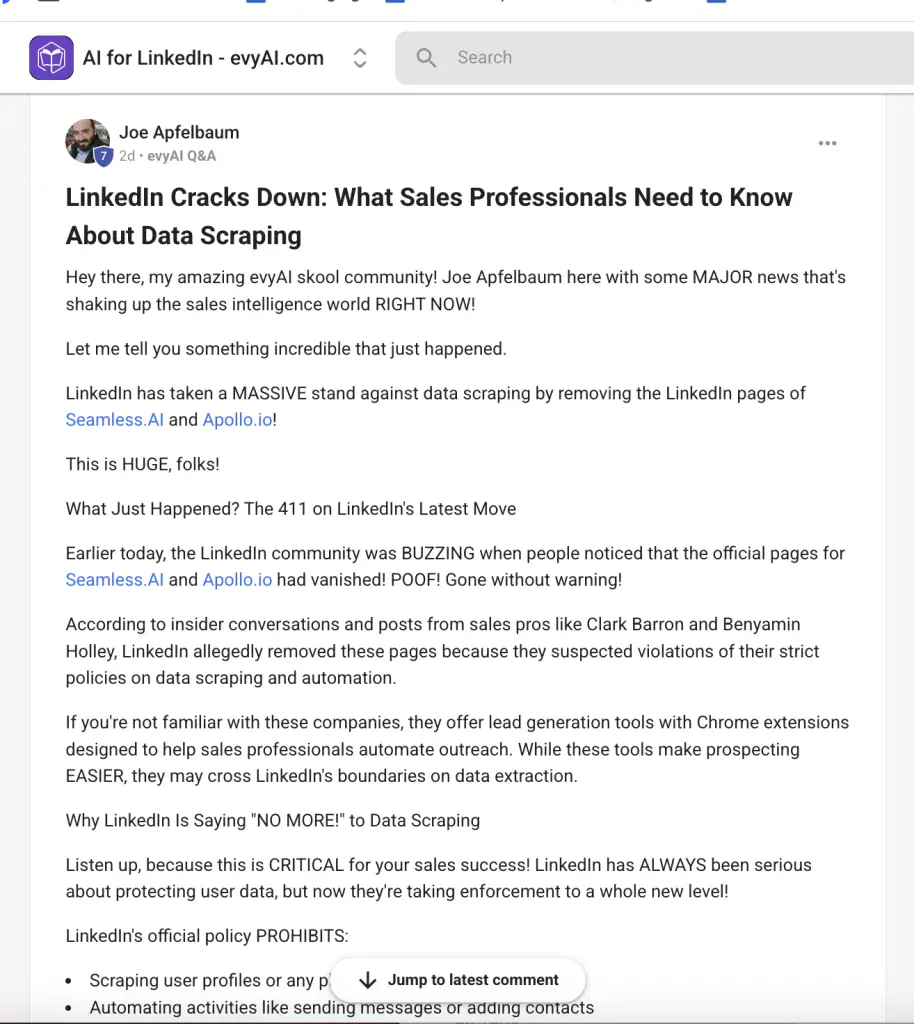
Automation bots face similar scrutiny:
![]()
ZenABM relies on official APIs. You get rich signals for automation without risking account health or compliance.
The data is first-party and reliable.
Next Steps
Automating LinkedIn ad data into a CRM is not about counting clicks. It is about observing the full account journey from first impression to closed revenue. In long B2B cycles with many participants, last click views miss the early touches that create demand.
Adopt an account-level and campaign-level model. Capture impressions, interactions, and clicks by company, then sync those fields to your CRM. ZenABM makes this workable with first-party data, fair attribution, live scoring, and plug-in dashboards. Once you see which ads move accounts forward, scaling becomes straightforward.
Ready to replace manual exports with a dependable pipeline?
Try ZenABM and automate LinkedIn ad data into your CRM with company-level accuracy.

